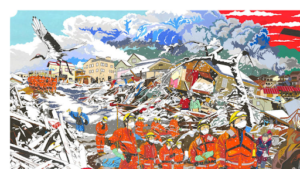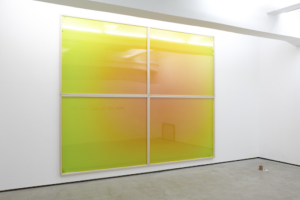A piece by Sabrina Bramwell, Delaney O’Shea, Joy Kim, Laura Montes, Brigid Goodman, and Molly Mattison.
What started off as a quiet and ordinary day turned into one of the most notorious natural disasters ever recorded in history. But, how exactly?On March 11, 2011, a magnitude 9.0 earthquake on the Richter Scale took place at a depth of 18.6 miles, in the northwestern side of Japan. Although the epicenter was located some 80 miles east of the city of Sendai, the effects of the great earthquake were felt around the world, from Norway’s fjords to Antarctica’s ice sheets. The Japan Earthquake also called the Great Sendai Earthquake or the Great Tohoku Earthquake and tsunami of 2011 had a combined total of 22,000 deaths and missing person reports. Deaths were caused by the initial earthquake and tsunami and by post-disaster health conditions as a result of other life-threatening factors. Devastatingly enough, Japan had 54 nuclear reactors with two under construction and 17 power plants which produced about 30% of Japan’s electricity. From the nationwide electrical damage, there was material damage from the earthquake and tsunami that estimated to cost 25 trillion yen (roughly 300 billion). As of February 2017, residents are still recovering from the disaster. Because of the cooling failure at the Fukushima Daiichi Nuclear Power Plant, which resulted in a level-7 nuclear meltdown and release of radioactive material, the damages are yet to be fully restored. This earthquake and its secondary effects were so powerful that it even caused changes in the earth’s axis. The legacy of this earthquake will linger for the years to come for its residents and the rest of the world.
Now, art.
There’s a trend in human history of using art to pass on impactful information. Art becomes a medium through which we can share knowledge, express reverence and even remind others of something that once was. Following the trend of civilizations past who used artforms like sculptures, carvings, pottery etc., the Great Tohoku Earthquake has resulted not only in long-lasting consequences, but also in art mediums which have captured the meaning of its experience to victims and witnesses.
Jave Yoshimoto created a forty-two-inch by thirty-foot, hand-painted scroll which shows the effects of the earthquake and tsunami, as well as community response to destruction in its wake. It is titled “Baptism of concrete estuary.” A portion of the scroll appears below.

One example of this history captured in art is its visual depictions.
Yoi Kawakubo took a different approach to the depiction of Japan’s tragedy, and more specifically of its nuclear consequences. Instead of traditional artforms, Kawakubo buried photographic film in an area of Fukushima, where it absorbed and displays radiation exposure. This piece is titled “When the mist takes off the suns.”

As a way of capturing the more immediate consequences of this seismic event, the Asahi Shimbun newspaper captured the photograph below, which shows toppled tombstones. These disturbed grave markers were a direct result of the 2011 earthquake and tsunami, and had still not been righted when the photo was taken five years later.

Jemisin tackles this concept of using art as a means of reminding people of significant events in history through different mediums in the Broken Earth Trilogy. This can be seen in the preservation of stonelore, or even the ancient creation of the plutonic engines—which were initially made as art— but looking at more obvious depictions it’s easy to forget that stone eaters look like sculptures. Stone eaters, besides appearing as statues and artistic mediums, are also embodiments of an archaic history. Some of their memories, though not perfect, span centuries and even millennia. Alabaster introduces us to this in The Obelisk Gate when he says, “they’ve been fighting this war much, much, longer than you or I. Some of them from the very beginning…They can’t die, so…yeah” (167). This gives the stone eaters a massive historic significance for the world Jemisin has created. Representationally, they are the most accurate—though still biased by human folly—perception of the true history of the Stillness than what’s been recorded and rewritten and destroyed.
Assessing the decision to grant this supreme knowledge to individuals who look like art leads us to critique another decision which lies in the selection of who is given access to this history. In terms of Hoa and Essun’s relationship we are told that he attaches himself to her from the earliest book in the trilogy. This is stated in The Obelisk Gate during an Interlude when Lerna questions Hoa’s devotion to Essun and Hoa says, “I love her, of course” (Jemisin 382). We know that not everyone in the Stillness is aware of stone eaters and so access to their knowledge is limited. So then, the fact that at least one motivator for sharing this knowledge is love speaks volumes on what art means for us as a civilization.
From destruction, we reconstruct; from harm, we sustain; through art, we love (?).
